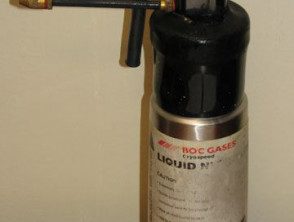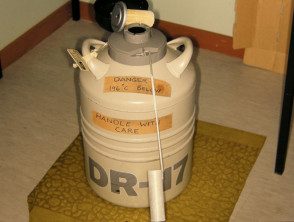Ad
Skin cancer
Application to facilitate skin self-examination and early detection. read more.
What is cryotherapy?
Cryotherapy refers to a treatment in which superficial skin lesions are frozen.
Cryogens used to freeze skin lesions include:
- Liquid nitrogen (the most common method used by doctors, temperature –196°C)
- Carbon dioxide snow (most used 20 years ago, –78.5°C)
- Dimethyl ether and propane or DMEP (available on the counter, –57°C)
Liquid Nitrogen Cryotherapy Equipment

Spray gun

Dewar flask

Dewar safety flask
Skin lesions treated with cryotherapy.
Injuries that can be treated with cryotherapy include:
- Actinic keratosis
- Viral warts
- Seborrheic Keratosis (senile warts).
Specialized dermatologists sometimes freeze small skin cancers, such as superficial ones. basal cell and in the place scaly cell carcinoma (intraepidermal carcinoma), but this is not always successful, so careful monitoring is necessary.
Freezing may be the most suitable way to get rid of many different types of superficial skin injury. It is relatively inexpensive, safe and reliable. However, it is important that the skin lesion has been properly diagnosed. Should not be used to treat melanoma or any undiagnosed pigmented lesion that could be melanoma.
The treatment
Cryotherapy is itchy and can be painful, at the time and for a variable period afterwards.
Liquid nitrogen
Liquid nitrogen cryotherapy involves the use of a cryospray, cryoprobe, or cotton-tipped applicator. Nitrogen is applied to the skin lesion for a few seconds or longer, depending on the type of lesion and the diameter and depth of the frostbite. The treatment is repeated in some cases, once thawing has been completed. This is known as “double freeze-thaw.”
cryotherapy procedure

Swabs

Spray gun

Spray viral warts
carbon dioxide snow
Carbon dioxide cryotherapy involves making a cylinder of frozen carbon dioxide snow or a slushie combined with acetone. It is applied directly to the skin lesion.
DMEP
DMEP comes in an aerosol can available without a prescription. It is used to treat warts using a foam applicator that is pressed onto the skin lesion for 10 to 40 seconds, depending on its size and location.
Immediate effects of cryotherapy.

Iceberg

Immediate swelling
Take care of the treatment area.
Immediate swelling and redness can be reduced by applying a current steroids on a single occasion immediately after freezing. Oral aspirin may also reduce inflammation and discomfort
The treated area will likely blister within a few hours, depending on the depth and duration of the frostbite. Sometimes the blister contains clear fluid, and sometimes it is red or purple due to bleeding (this is harmless). Treatment near the eye may result in a swollen eyelid, especially the next morning, but the swelling subsides within a few days. Within a few days, a scab forms and the blister gradually dries up.
Usually no special attention is needed during the healing phase. The treated area can be gently washed once or twice a day and should be kept clean. A bandage is optional but is advisable if the affected area is subject to trauma or clothes rub.
When the blister dries to a scab, apply Vaseline and avoid touching it. The scab peels off after 5 to 10 days on the face and 3 weeks on the hand. A sore or scab may persist for up to 3 months on the lower leg because healing at this site is often slow.
Delayed effects of cryotherapy

Hemorrhagic blisters

Clear, hemorrhagic blisters

Eyelid swelling
Cryotherapy results
After a standard freeze of actinic keratosis, seborrheic keratosis or viral wart, the skin may appear completely normal without any sign of the original skin lesion. It may take several treatments to achieve this.
Complications of cryotherapy.
The main concern is secondary injury infection, but this is rare. The infection may increase pain, swelling, thick, yellow fluid in the blister, purulent download and/or redness around the treated area. Consult your doctor if you are concerned: topical antiseptics and/or oral antibiotics may be necessary.
Other undesirable effects may include:
- Delayed healing and ulceration
- Local nerve damage (usually temporary)
- Permanent hypopigmentation or scar
- Persistent or recurrent skin lesions, requiring additional cryotherapy, surgery or other treatment.
Complications of cryotherapy.

Prolonged healing

Secondary infection

Recurrent basal cell carcinoma

